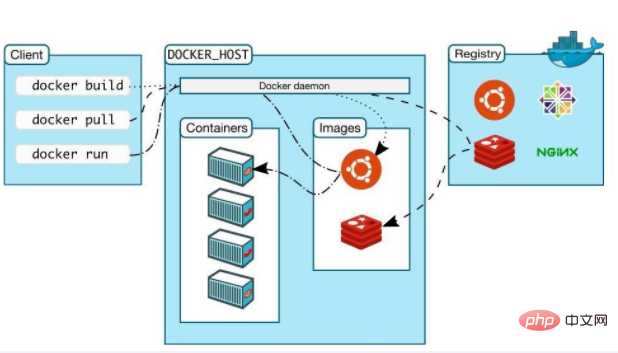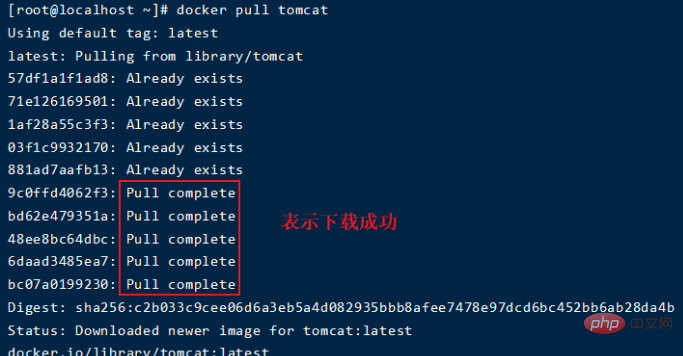What is the mapping of docker
In docker, mapping refers to the process in the container that is used to interact with the outside. Commonly used is the mapping between the port in the container and the host. Through port mapping, the host can be accessed from the outside. Specify the port to access the container application.

The operating environment of this tutorial: linux7.3 system, docker-1.13.1 version, Dell G3 computer.
What is docker mapping
1. What is Docker mapping?

The application is running in the container, and external access and interaction are required, which involves the mapping between the port in the container and the host;
Through With port mapping, we can access the specified port of the host from the outside to access the container application;
2, how to implement Docker mapping?
Here we take Tomcat as an example to see how to access Tomca in the host host externally through Docker port mapping.
2.1, download tomcat container image
Download image: docker pull tomcat:tag, if you don’t add a version number, the latest version will be downloaded by default

View all images: docker images, I have downloaded three versions of tomcat here

2.2, create and start tomcat Container
Create and start the tomcat container: docker run --name tomcat1 -d tomcat :latest, where -d means running the container in the background, tomcat1 is the container name, and tomcat :latest indicates the version number

View running containers: docker ps

2.3, open port mapping command
Mapping command: docker run --name container name -d -p (server port): (Docker port) image-name
--name: Custom container name, when not specified, Docker will automatically generate a name
-d: indicating the background running container
Server port: the tomcat port here is 8080
Docker port: We can set a port number arbitrarily, But the premise is that this port number cannot be occupied
image-name: Specify the running image name and Tag. You can also use the image ID here

At this time our port is set up. We enter the server IP address in the browser (view command: ip addr show) plus the Docker port to access it.
Recommended learning: "docker video tutorial"
The above is the detailed content of What is the mapping of docker. For more information, please follow other related articles on the PHP Chinese website!

Hot AI Tools

Undresser.AI Undress
AI-powered app for creating realistic nude photos

AI Clothes Remover
Online AI tool for removing clothes from photos.

Undress AI Tool
Undress images for free

Clothoff.io
AI clothes remover

AI Hentai Generator
Generate AI Hentai for free.

Hot Article

Hot Tools

Notepad++7.3.1
Easy-to-use and free code editor

SublimeText3 Chinese version
Chinese version, very easy to use

Zend Studio 13.0.1
Powerful PHP integrated development environment

Dreamweaver CS6
Visual web development tools

SublimeText3 Mac version
God-level code editing software (SublimeText3)

Hot Topics
 1378
1378
 52
52
 How to import docker images
Apr 15, 2025 am 08:24 AM
How to import docker images
Apr 15, 2025 am 08:24 AM
Importing images in Docker involves getting prebuilt container images from remote repositories and importing them into local repositories. The steps include: pull the image (docker pull) list the docker images (docker images) and import the image to the local repository (docker import)
 What platform Docker uses to manage public images
Apr 15, 2025 am 07:06 AM
What platform Docker uses to manage public images
Apr 15, 2025 am 07:06 AM
The Docker image hosting platform is used to manage and store Docker images, making it easy for developers and users to access and use prebuilt software environments. Common platforms include: Docker Hub: officially maintained by Docker and has a huge mirror library. GitHub Container Registry: Integrates the GitHub ecosystem. Google Container Registry: Hosted by Google Cloud Platform. Amazon Elastic Container Registry: Hosted by AWS. Quay.io: By Red Hat
 How to set up docker pulling mirror
Apr 15, 2025 am 08:33 AM
How to set up docker pulling mirror
Apr 15, 2025 am 08:33 AM
Docker can customize settings when pulling images, including: specifying the image version, mirror repository, speed limit pull, authentication, and pulling tagless images. These settings can be implemented through the docker pull command and its options, including --registry, --limit-rate, --auth, and -a.
 How to stop docker network connection
Apr 15, 2025 am 10:21 AM
How to stop docker network connection
Apr 15, 2025 am 10:21 AM
To stop a Docker network connection, follow these steps: 1. Determine the name of the network to stop; 2. Use the docker network stop command to stop the network; 3. Check the stop status to verify that the network is stopped.
 Docker application development
Apr 15, 2025 am 07:03 AM
Docker application development
Apr 15, 2025 am 07:03 AM
Docker application development uses containers to package and deploy applications, providing isolation, portability, consistency, rapid deployment, and version control. The processes include writing code, creating Dockerfiles, building images, running containers, and deploying. Additionally, Docker volumes can be used for data persistence, networks enable secure communication between containers, and orchestration tools can manage large-scale deployments.
 What to do if the docker warehouse is hung
Apr 15, 2025 am 07:57 AM
What to do if the docker warehouse is hung
Apr 15, 2025 am 07:57 AM
When a Docker repository is hung up, you can do the following: Check the network connection and restart the Docker service; use a local image or try to replace the repository; create your own repository or contact the repository provider.
 How to exit docker into container
Apr 15, 2025 am 08:03 AM
How to exit docker into container
Apr 15, 2025 am 08:03 AM
How to exit the Docker container: Run the docker stop <Container name or ID> command to send a stop request to the Docker daemon. The daemon sends a SIGTERM signal to the container to exit with a controllable exit, and if it does not exit within 10 seconds, a SIGKILL signal is sent to exit forcibly.
 How to deploy a project by docker
Apr 15, 2025 am 08:21 AM
How to deploy a project by docker
Apr 15, 2025 am 08:21 AM
By using Docker, you can package your applications into portable images for rapid deployment in different environments. First create a Docker image that contains the application and its dependencies, and then run the Docker container. To deploy an application, expose the port of the container. Additionally, it is recommended to use version control, continuous integration, and monitoring tools to enhance your Docker deployment.




